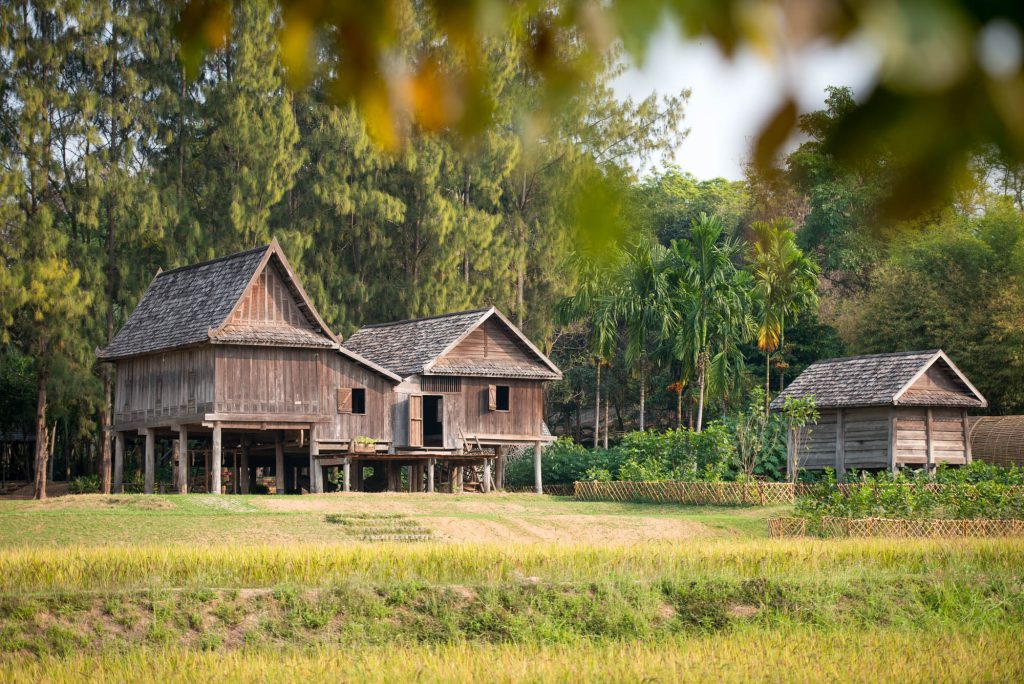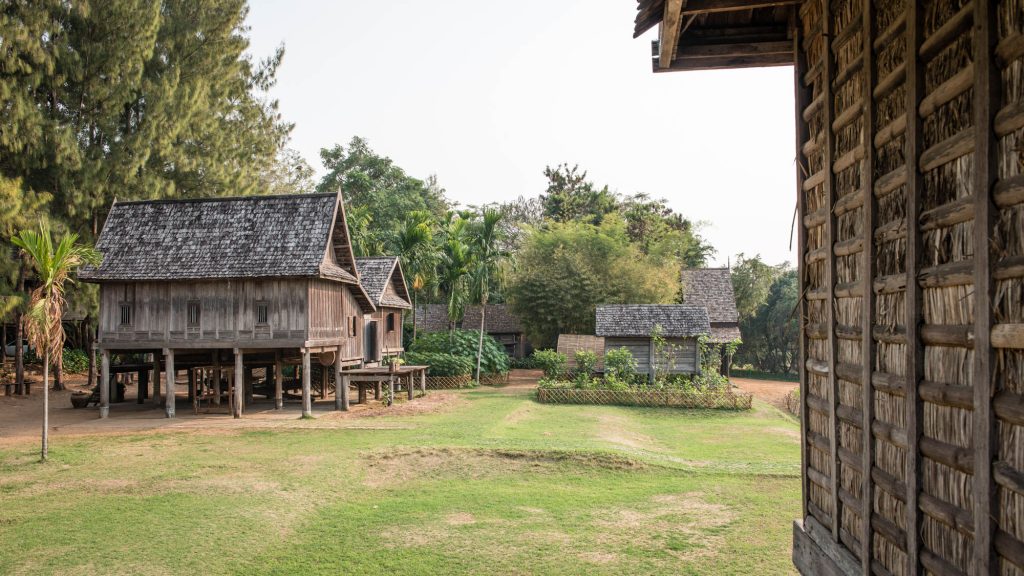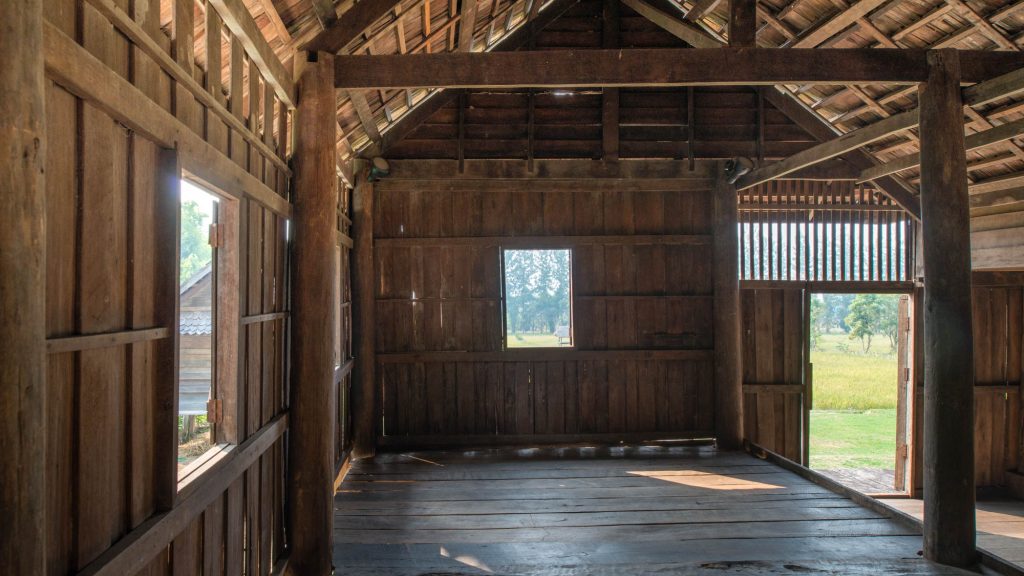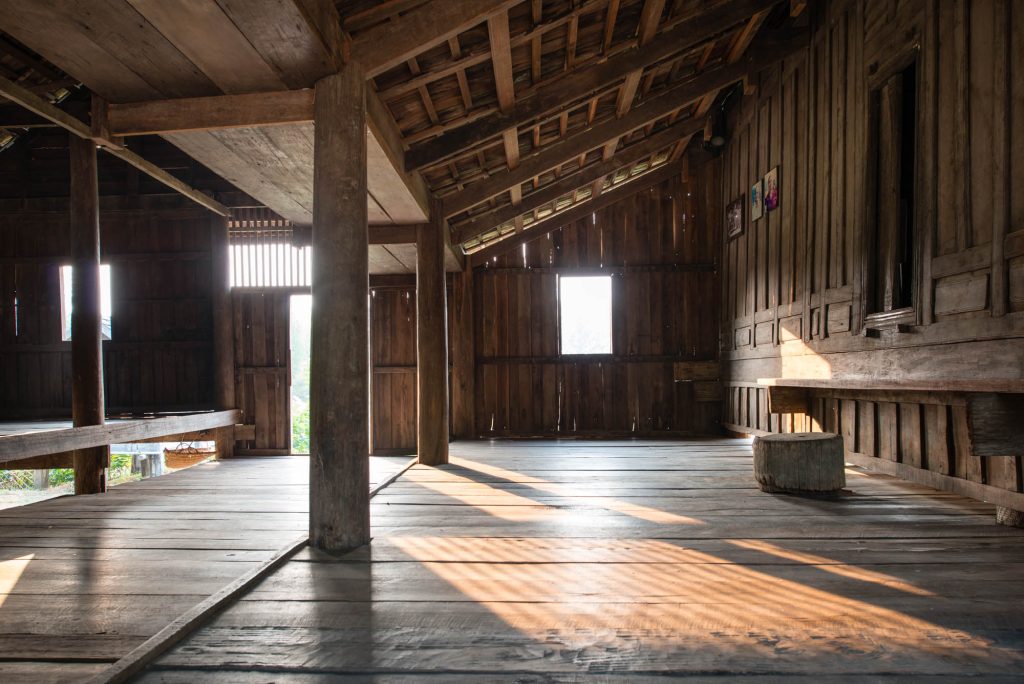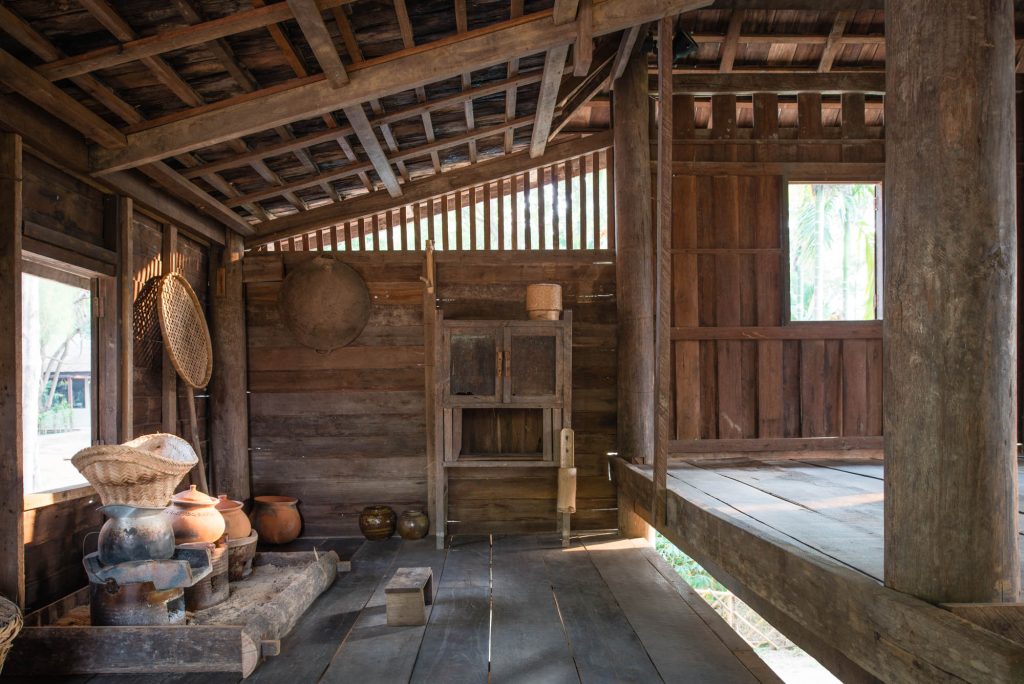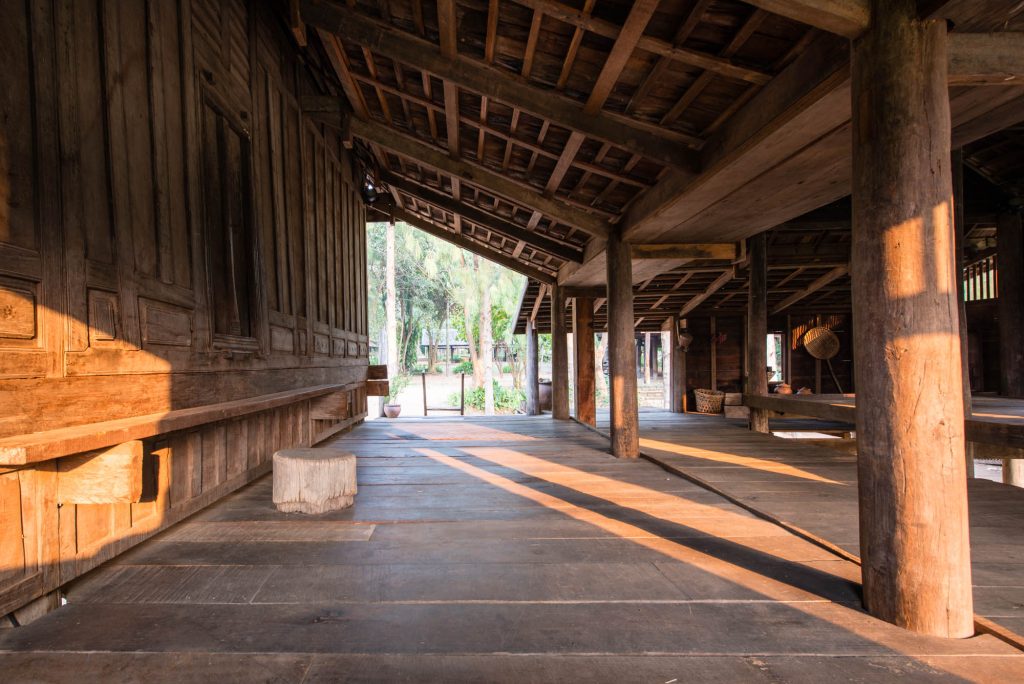บ้านปลุกปรีดี
อ่านเพิ่มเติม
บ้านปลุกปรีดี
- ที่ตั้ง หมู่บ้านเกษตรนิเวศ ถนนแจ้งวัฒนะ กรุงเทพมหานคร
- สถาปนิก/ผู้ออกแบบ สถาปนิกผู้บูรณะ: ดร. ยุวรัตน์ เหมะศิลปิน
- ผู้ครอบครอง ครอบครัว จุลสมัยและสูตะบุตร
- ปีที่สร้าง พุทธศักราช 2464 – 2470
ประวัติ
บ้านปลุกปรีดี ถือเป็นบ้านพักตากอากาศหลังแรกๆ ที่ถูกสร้างขึ้นที่ชายทะเลชะอำ และเป็นกลุ่มตำหนักของพระเจ้าบรมวงศ์เธอ กรมพระนราธิปประพันธ์พงศ์ ซึ่งทรงเป็นผู้บุกเบิก ก่อตั้ง และพัฒนาชายทะเลแห่งนี้ให้มีความเจริญก้าวหน้าไม่แพ้หัวหินในยุคเดียวกัน โดยในพุทธศักราช 2470 กรมพระนราธิปพระพันธ์พงศ์ประทานที่ดินและกลุ่มเรือนปลุกปรีดีให้แก่หม่อมเจ้าหญิงวรรณีศรีสมร พระธิดาที่เกิดจากหม่อมต่วนใหญ่ วรวรรณ ณ อยุธยา (หม่อมลำดับที่ 1 ในพระองค์) หลังจากหม่อมเจ้าหญิงวรรณีศรีสมรสิ้นพระชนม์ ที่ดินถูกขายต่อให้กับนางเลื่อน จุลสมัย ในพุทธศักราช 2486 และบ้านปลุกปรีดีได้กลายมาเป็นที่พักตากอากาศของครอบครัวจุลสมัยและสูตะบุตรในทุกๆ ฤดูร้อน มีการต่อเติมตัวเรือนหลายครั้งเพื่อให้สอดคล้องกับการใช้งานในแต่ละยุคลูกหลานที่เติบโตในบ้านนี้มีความทรงจำที่ดีเกี่ยวกับบ้านและเมืองชะอำที่ยังคงมีความอบอุ่นเป็นกันเองระหว่างคนในพื้นที่และผู้มาพักในยุคต่อๆ มา จนกระทั่งความเจริญทางเศรษฐกิจของเมืองตากอากาศชายทะเลทั้งสองฝั่งอ่าวไทยแพร่ขยายมาถึงชะอำ ทำให้มีผู้คนมาเที่ยวชายหาดกันมากขึ้น การจัดระเบียบของเมืองยังไม่สามารถควบคุมความเป็นระเบียบเรียบร้อยและการพัฒนาที่เกิดขึ้นอย่างรวดเร็วตลอดแนวชายฝั่งให้เหมาะสมได้ ทำให้ถนนเลียบชายหาดชะอำโดยเฉพาะหน้าบ้านปลุกปรีดี มีสภาพพลุกพล่านและมีการจับจองพื้นที่ค้าขายอย่างไม่เป็นระเบียบ ทำให้คนในครอบครัวเริ่มห่างหายจากการมาพักที่นี่ บ้านถูกทิ้งให้ทรุดโทรมเพราะขาดการดูแลอย่างต่อเนื่องและเหมาะสม ในที่สุดจึงตัดสินใจรื้อและย้ายบ้านปลุกปรีดีมาสร้างใหม่ในกรุงเทพมหานคร เพื่อคืนชีวิตให้บ้านปลุกปรีดีกลับมาเป็นศูนย์รวมและที่พักผ่อนหย่อนใจของครอบครัวต่อไปในอนาคต
การบูรณะบ้านปลุกปรีดีเริ่มจากการสำรวจและรังวัดอาคารหลักและเรือนครัว ทำการสืบค้นภาพถ่ายในอดีตเพื่อใช้อ้างอิงในการบูรณะให้กลับไปสู่สภาพก่อนมีการต่อเติม กำหนดหมายเลขอ้างอิงของชิ้นส่วนไม้เพื่อใช้ในการประกอบโครงสร้างกลับขึ้นมาใหม่ ส่วนต้นลั่นทมใหญ่ที่อยู่คู่บ้านซึ่งไม่สามารถเคลื่อนย้ายมาได้ มีการตัดเก็บกิ่งบางส่วนเพื่อนำมาขยายพันธ์และปลูกในตำแหน่งที่สัมพันธ์กับตัวบ้านตามเดิม การจัดวางบ้านในที่ดินแห่งใหม่ยังคงคำนึงถึงทิศทางของลมให้ตรงตามลักษณะของการรับลมทะเลอย่างที่เคยเป็นมา เพื่อส่งเสริมให้เกิดบรรยากาศที่ใกล้เคียงกับชะอำมากที่สุด ใต้ถุนบ้านถูกยกให้สูงขึ้นจากเดิมและเพิ่มฐานปูนปั้นตามแบบพระราชนิเวศน์มฤคทายวัน เนื่องจากฐานไม้มีการผุกร่อนจากความชื้นและเพื่อให้การใช้งานส่วนใต้ถุนมีความโปร่งโล่งและอยู่สบายมากขึ้น มีการเสริมการใช้งานให้เหมาะสมกับความต้องการในปัจจุบัน ได้แก่ทางลาดเพื่อผู้สูงอายุในครอบครัว และการต่อเติมครัวที่ใต้ถุนและห้องน้ำทั้งชั้นบนและชั้นล่าง ซ่อมแซมฝาไหลในส่วนระเบียงหน้าห้องนอน ซึ่งเป็นเอกลักษณ์สำคัญของบ้านนี้ สีทาภายในและภายนอกทั้งหมดอ้างอิงจากภาพถ่ายและการสำรวจสภาพก่อนการรื้อถอน
ปัจจุบัน บ้านปลุกปรีดี ถูกใช้เป็นห้องสมุดและที่รับรองของหมู่ญาติมิตร โดยใช้เป็นที่สังสรรค์ของครอบครัวอยู่เป็นประจำหรืออาจกล่าวได้ว่าบ่อยครั้งกว่าเมื่อสมัยที่อยู่ที่ชะอำ ตรงตามจุดประสงค์ของครอบครัวที่ต้องการสืบต่อชีวิตของบ้านหลังนี้ให้อยู่ต่อไปในอนาคต บ้านปลุกปรีดีจึงเป็นตัวอย่างของการอนุรักษ์โดยการย้ายที่ตั้ง สามารถเป็นแหล่งเรียนรู้ทางสถาปัตยกรรมแบบบังกะโลตากอากาศในสมัยรัชกาลที่ 6 ซึ่งได้รับอิทธิพลจากรูปแบบสถาปัตยกรรมของพระราชนิเวศน์มฤคทายวันซึ่งสร้างขึ้นในพื้นที่และเวลาใกล้เคียงกันได้เป็นอย่างดี
Ban Pluk Predee
- Location: Kaset Nives Village, Chaengwattana Road, Bangkok
- Architect/ Designer Restoration Architect: Dr. Yuwarat Hemasilapin
- Owner Chulasamaya and Sootabutra Family
- Year Built 1921 – 1927
History
Baan Pluk Predee, one of the very first summer houses in Cha-Am seaside, was once part of the royal residence of Prince Narathippraphanphong, a pioneer in promoting the development of this seaside town to be as urbanized as Hua-Hin in the same era. In 1927, Prince Narathippraphanphong transferred the estate and the group of Ruan Pluk Predee to Princess Wanneesrisamosorn, his eldest daughter born to Mom Tuan Yai Worawan Na Ayutthaya. After Princess Wanneesrisamosorn passed away, the property was sold in 1943 to Nang Luan Chulasamaya and Pluk Predee villa has became the summer house of the Chulasamaya and Sutabutra families since. The house had undergone several renovations to fit the needs of each generation of the families. The children had fond memories of growing up in this family home and Cha-Am remains a peaceful town where local folks are always friendly to those visiting. Eventually, the economic growth in other seaside towns along both side of the Gulf of Thailand expanded to Cha-Am which resulting in the increasing amount of tourists. The town’s organization plan went out of control and it was impossible to properly manage orders. Rapid growth along the coast caused congestion along Cha-Am’s seaside street especially right out front of Pluk Predee house where street vendors claimed spaces on sidewalk and sell their products disorderly. The family refrained from staying at the house ever since. Eventually, the house was abandoned and ruined due to the lack of proper care and maintenance. Finally, the owners decided to dismantle the house and rebuild it at a new location in Bangkok to bring Pluk Predee house back to life and for the house to remain the families’ recreational gathering place for the years to come.
The restoration of Pluk Predee house began with the surveying of the main house and the kitchen unit. Old photographs are used as reference in restoring the building back to its original design before all the alterations. Part numbers were assigned to each piece of wood used in the rebuilding of the house structure. As the large plumeria tree that was with the house at the original location cannot be moved, branches were taken back to breed and grow in the position that correspond to the house. The position of the house at the new location still took wind directions into consideration to imitate the flowing of the sea breeze through the house like when it was on Cha-Am beach. The house was raised higher in order to add comfort as well as bright and airy look to the space under the house. Concrete block foundation similar to the one at Maruekhathaiyawan Palace was added as the old wooden base has corroded from moisture. Accessories were added to meet the current needs such as a wheelchair ramp for the senior members of the family, the kitchen in the area under the house as well as upstairs and downstairs bathrooms. The repair of the sliding window shutters on the bedroom balcony which is a dominant feature of the house.
Old photographs and information from the survey before the building was taken apart was used as a reference in selecting interior and exterior paint colors.
Today, Pluk Predee house is a library and a family gathering place. The house has been frequently used to host the family parties, or it can be said that it is even more frequent than when it was in Cha-Am which was the family’s exact purpose of this restoration project – to extend the life of the house into the future.Pluk Predee house is another example of preservation through relocation and is regarded as another learning center for bungalows architecture built in the reign of King Rama VI and influenced by Maruekhathaiyawan Palace which was built in the nearby location and during the same period of time.
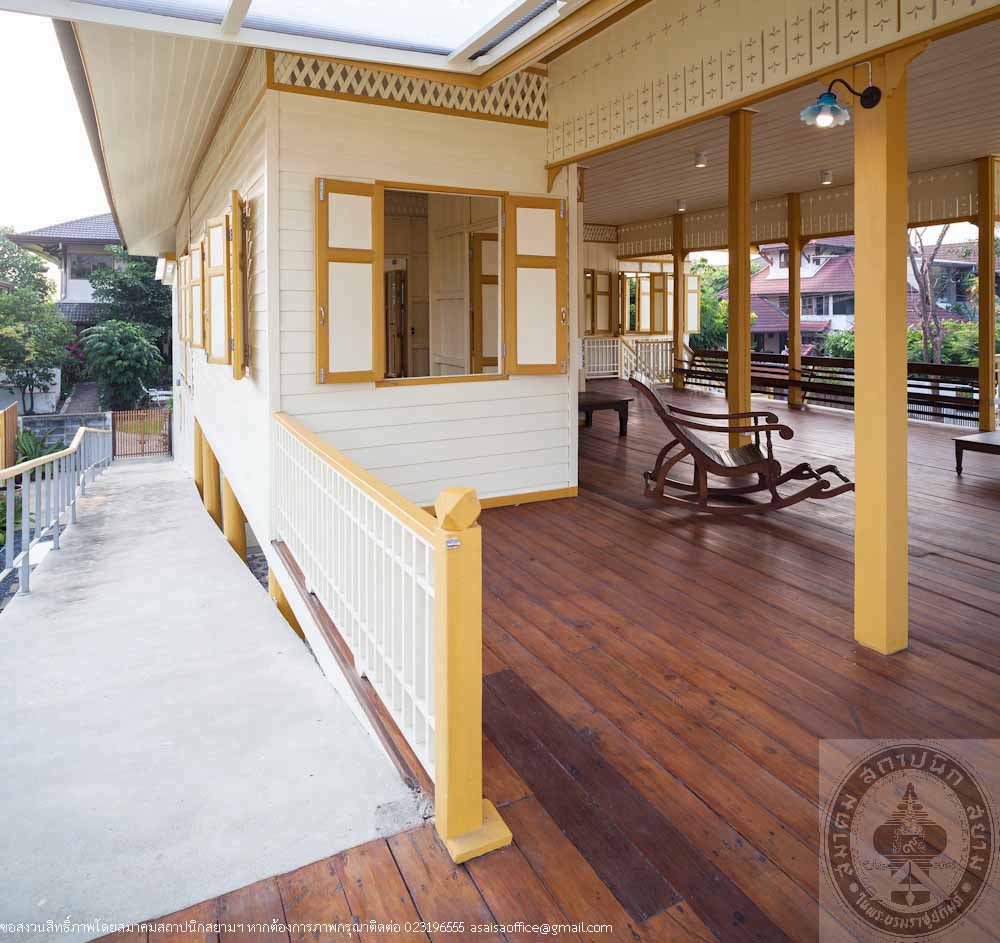
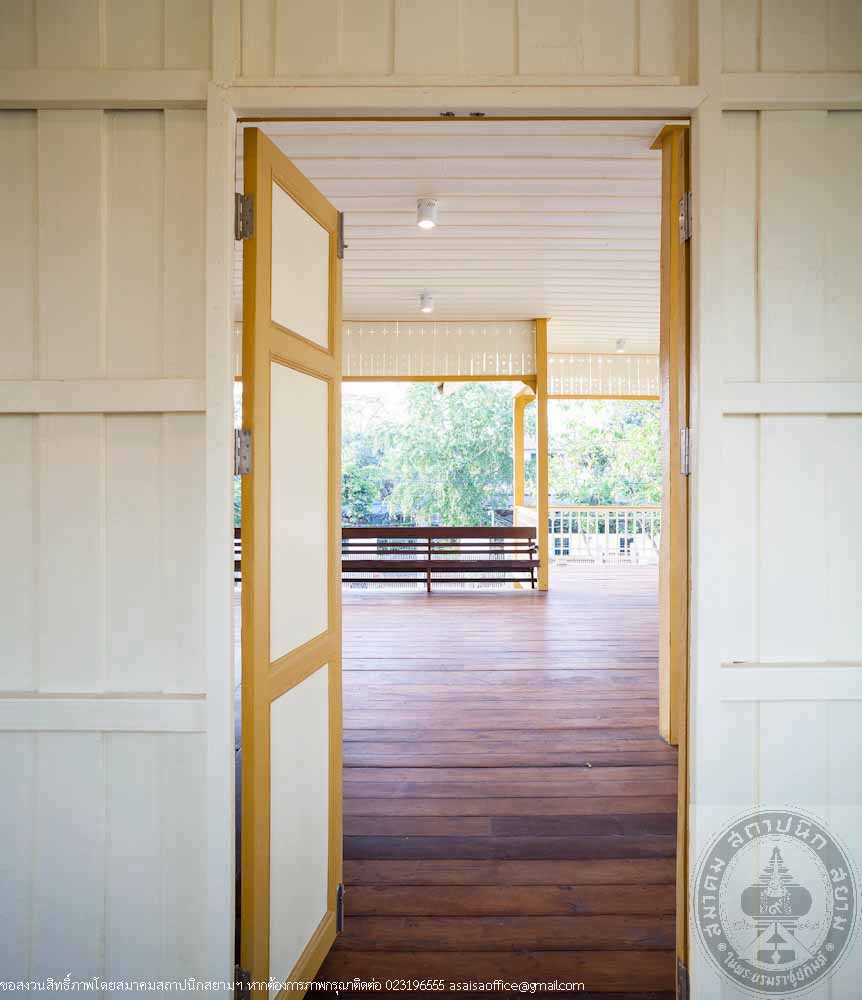
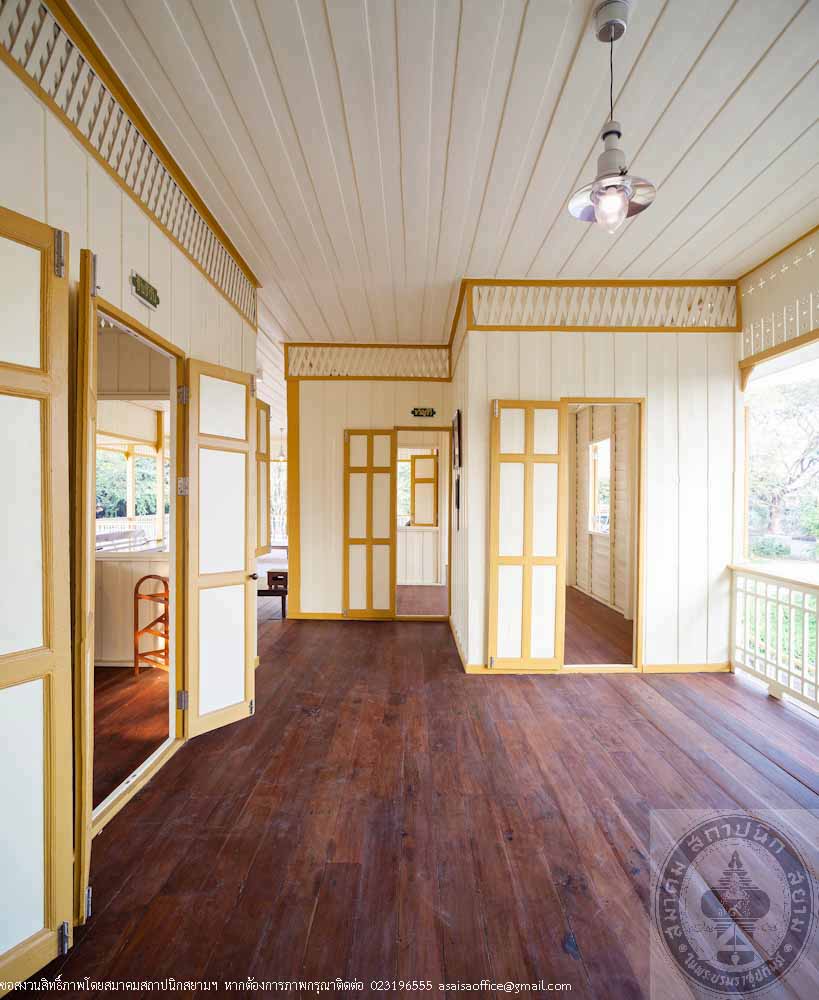
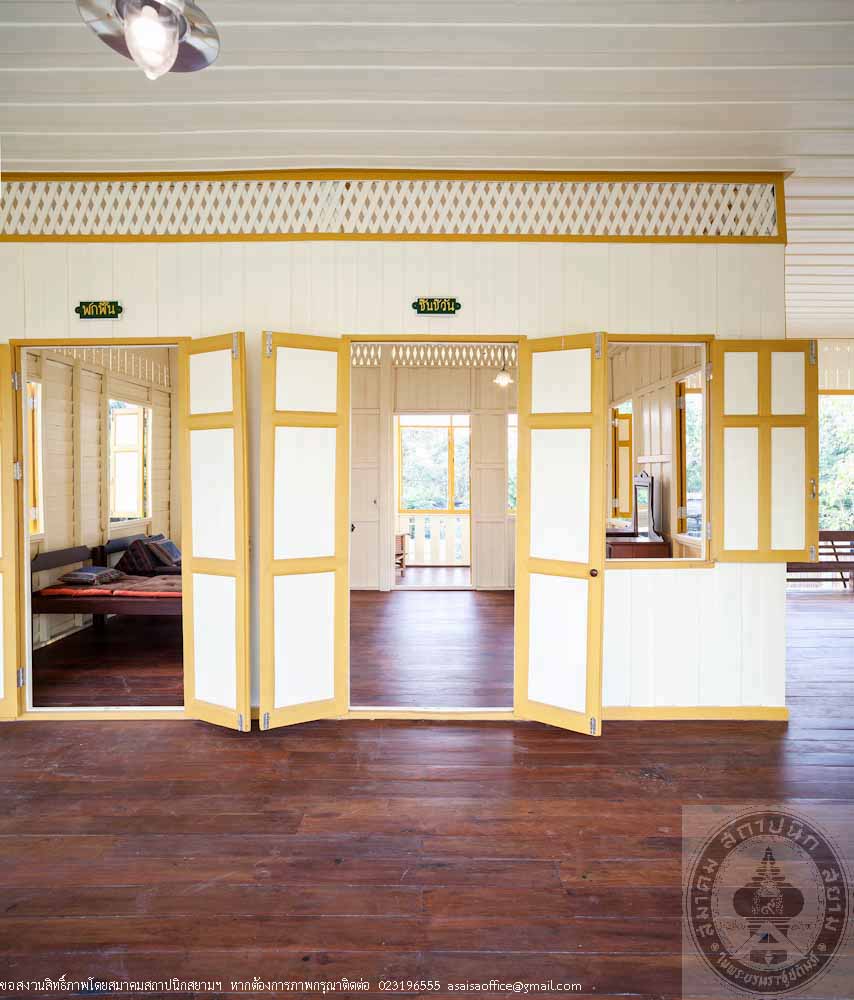
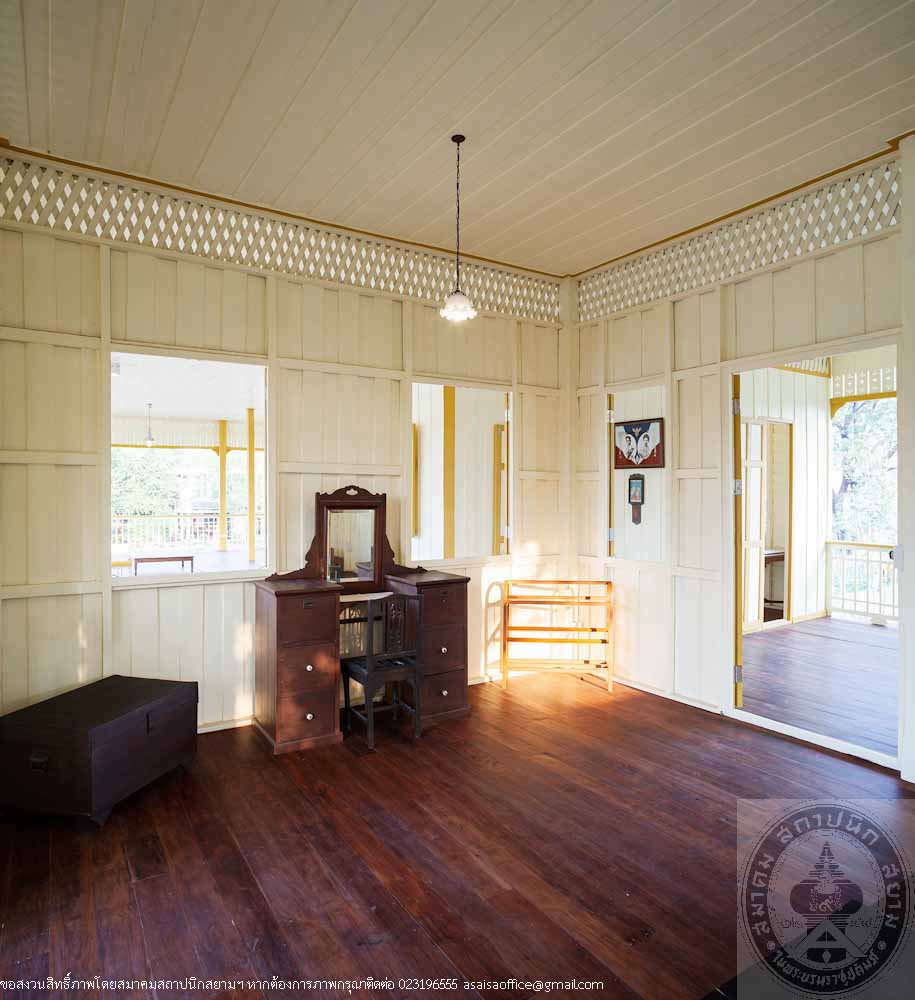
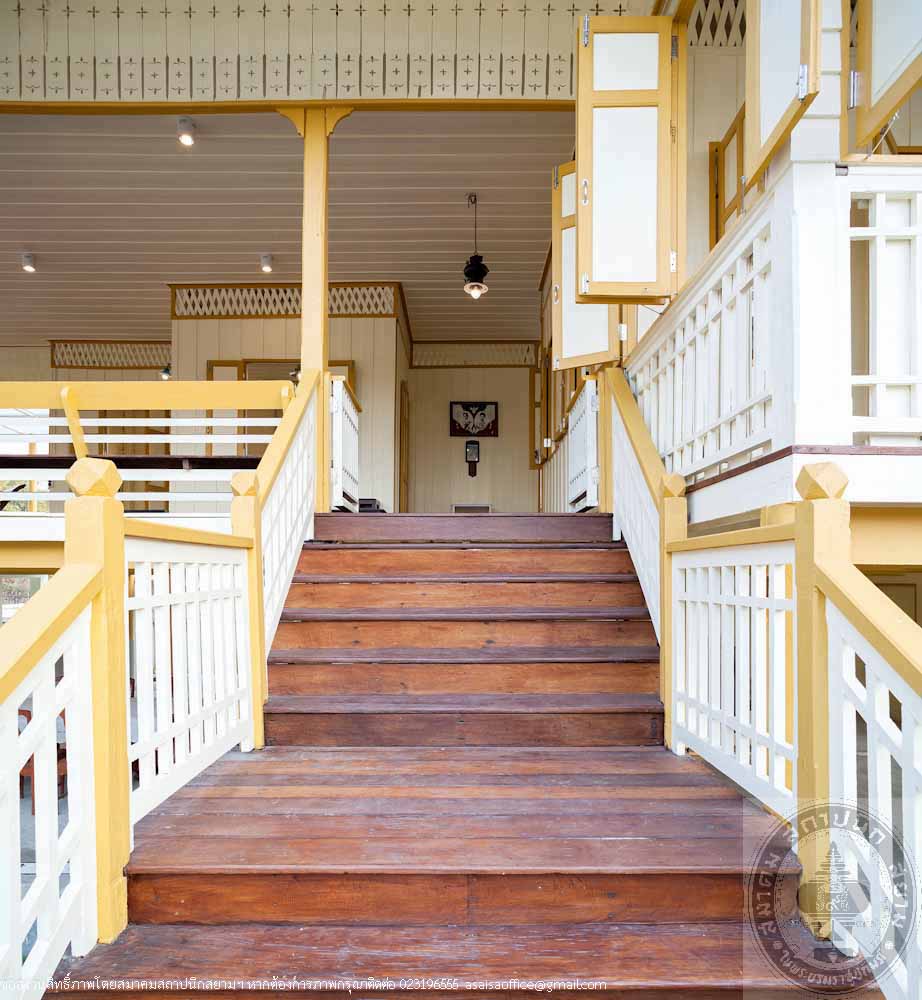
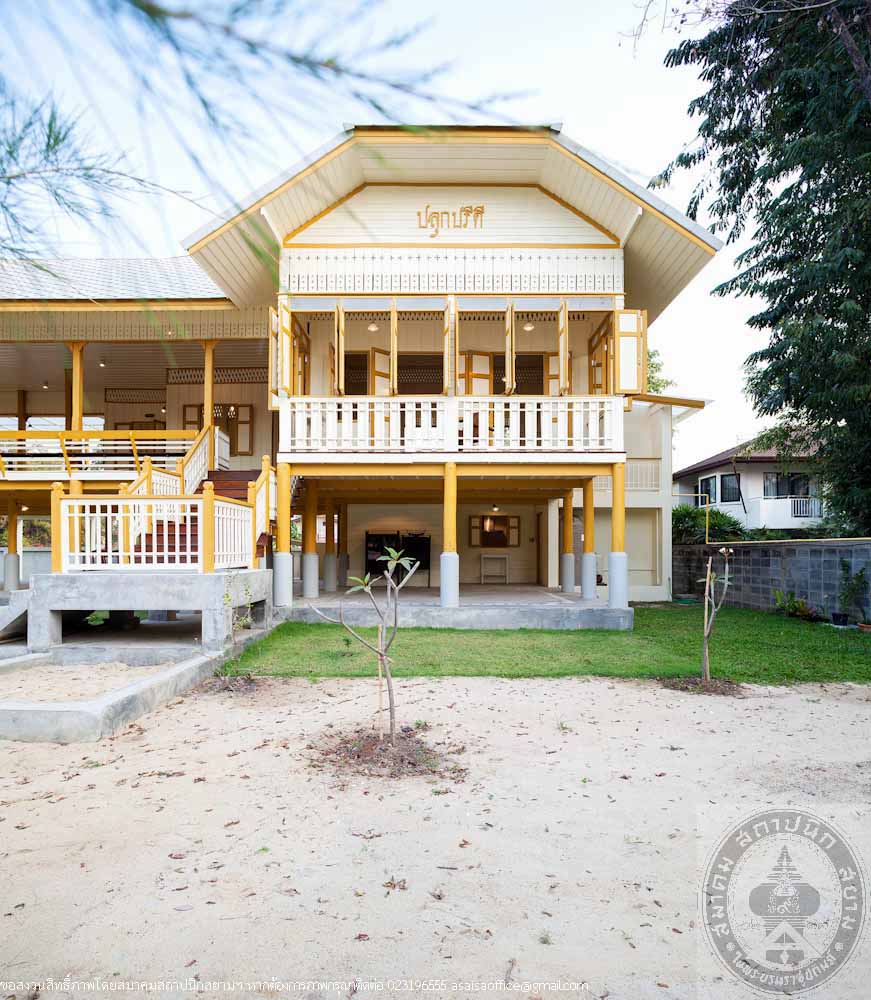
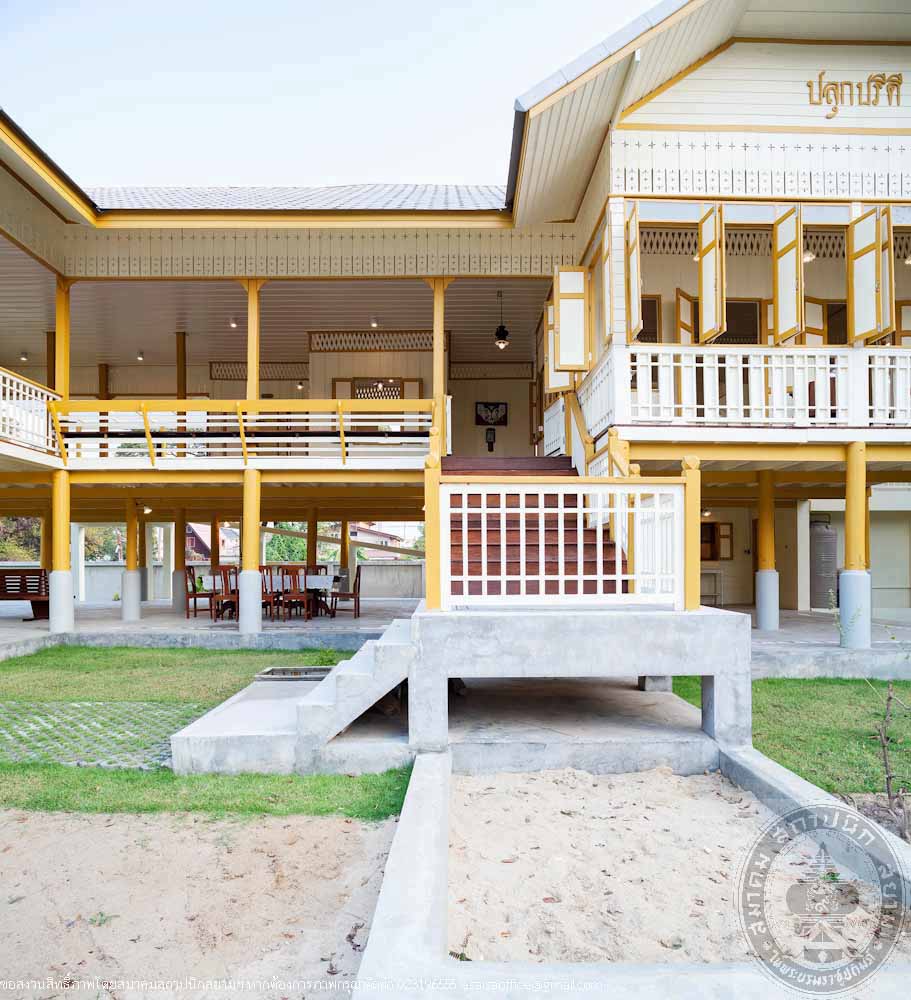
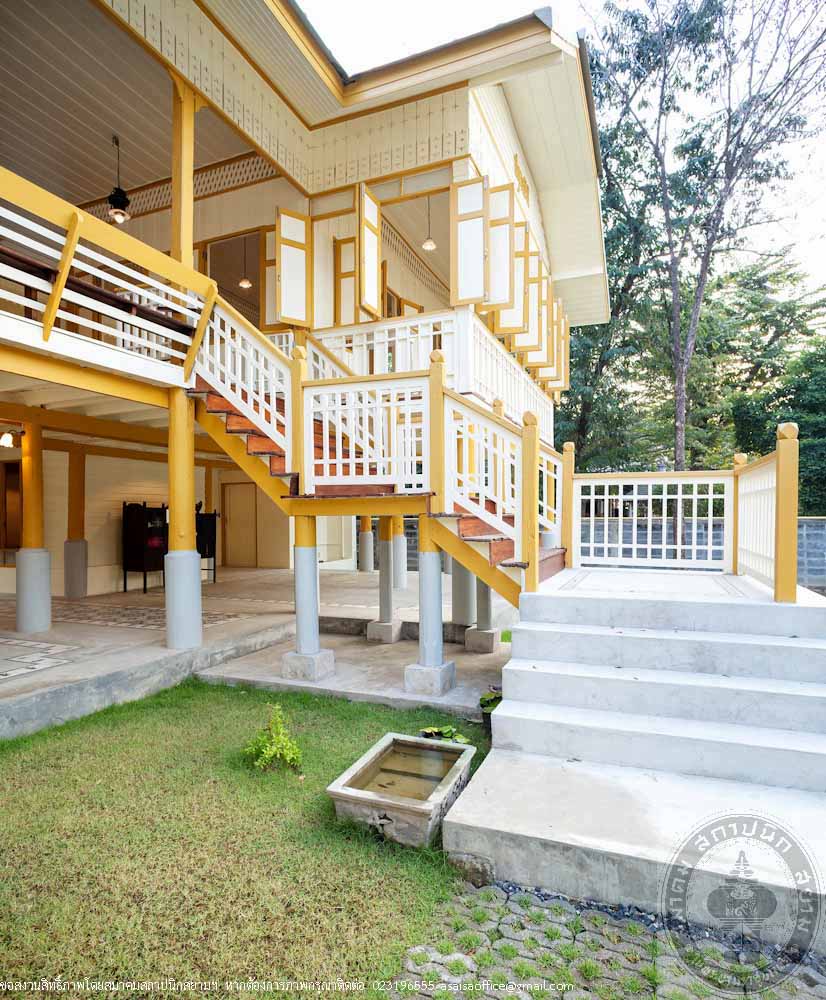


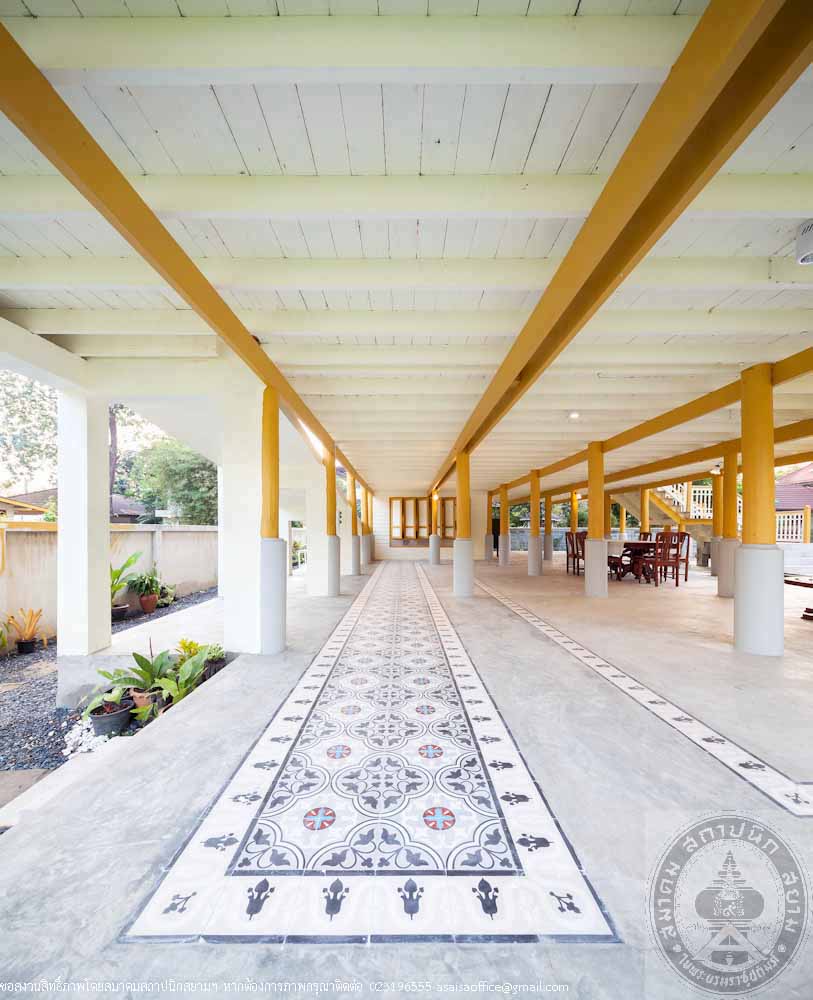
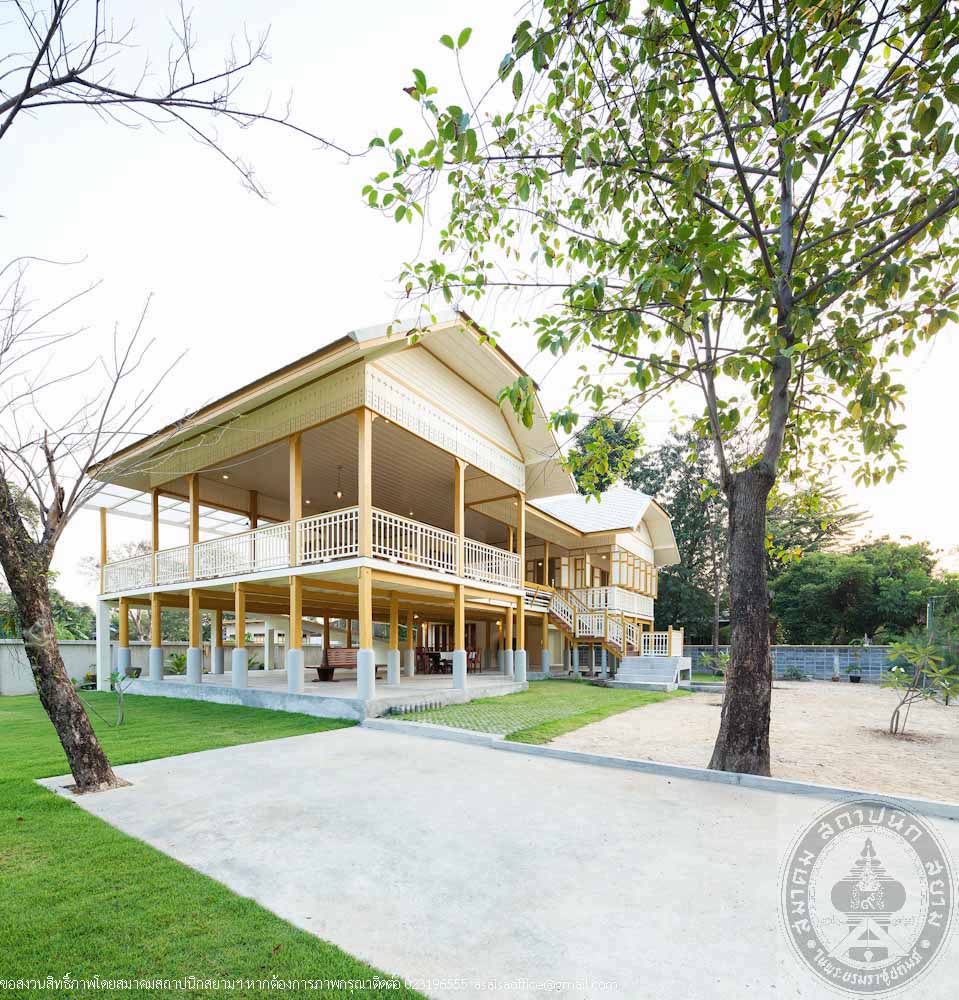
เรือนประเสนชิต
อ่านเพิ่มเติม
เรือนประเสนชิต
- ที่ตั้ง เลขที่ 111 หมู่ที่ 2 ตำบลหมูสี อำเภอปากช่อง จังหวัดนครราชสีมา
- สถาปนิก/ผู้ออกแบบ สถาปนิกผู้บูรณะ: นายอรรถดา คอมันตร์ และ นายจักร กาญจนกาศ
- ผู้ครอบครอง นายอรรถดา คอมันตร์
- ปีที่สร้าง ประมาณพุทธศักราช 2450
ประวัติ
เรือนประเสนชิตเดิมตั้งอยู่บนที่ดินของมหาเสวกตรี พระยาราชอักษร (ใช้ อัศวรักษ์) ถนนสี่พระยากรุงเทพมหานคร เป็นที่อยู่อาศัยของชนชั้นระดับขุนนางในสมัยนั้น หลังจากนั้นได้ตกอยู่ในการครอบครองของตระกูลคอมันตร์ ต่อมาในพุทธศักราช 2555 เจ้าของได้วางแผนอนุรักษ์เรือน โดยเริ่มจากการบันทึกข้อมูลด้านประวัติศาสตร์ โบราณคดี สถาปัตยกรรม การประเมินความแท้และบูรณภาพ การบันทึกข้อมูลก่อนรื้อถอนและย้ายอาคาร การถ่ายภาพ การทำเครื่องหมายของชิ้นส่วนทุกชิ้นอย่างละเอียดและระมัดระวัง เพื่อนำมาประกอบใหม่ให้สมบูรณ์และคงสภาพเดิม สำหรับการอนุรักษ์นั้น ได้ใช้วัสดุใกล้เคียงของเดิมมากที่สุด เช่น การใช้ไม้สักเก่า เครื่องเรือน สวิทซ์ ปลั๊กไฟ โคมไฟ ภาพประดับ และเครื่องใช้ตามแบบโบราณ รวมทั้งการทาสีอาคารตามแบบดั้งเดิม มีการดัดแปลงห้องด้านหลังสองห้องเป็นห้องน้ำ ส่วนระเบียงชั้น 1 ปูหินอ่อนแทนพื้นไม้เดิมเพื่อประโยชน์ในการใช้สอยและการบำรุงรักษา โดยเริ่มดำเนินการรื้อถอนตั้งแต่เดือนพฤศจิกายน พุทธศักราช2555 บูรณะเสร็จสมบูรณ์เดือนตุลาคม พุทธศักราช 2557
เรือนประเสนชิตเป็นอาคารไม้ 2 ชั้น หลังคาปั้นหยา มุงด้วยกระเบื้องซีเมนต์โครงสร้างอาคารด้านล่างเป็นฐานปูน (ตามแบบเดิม) ส่วนตัวอาคารทั้งหมดเป็นไม้สัก หลังคา อาคารกว้าง 11 เมตร ยาว 15.5 เมตร พื้นที่ใช้สอยโดยประมาณ 340 ตารางเมตร ภายในอาคารแบ่งออกเป็น 10 ห้อง พื้นที่แต่ละห้องถูกจัดสรรอย่างเหมาะสม เช่น ห้องนอน ห้องรับแขก และห้องทำงาน เป็นต้น มีระเบียงขนาดใหญ่ด้านหน้าและด้านข้างบ้านมีการประดับตกแต่งอาคารบริเวณลูกกรงและไม้ฉลุลายในส่วนช่องแสง แผงกันแดด ราวระเบียงและบันได
ปัจจุบัน เรือนประเสนชิต ถูกใช้เป็นเป็นพิพิธภัณฑ์เกี่ยวกับที่อยู่อาศัยของขุนนางไทยสมัยรัชกาลที่ 5–6เพื่อเป็นแหล่งเรียนรู้ทางวัฒนธรรม การอยู่อาศัย และเครื่องเรือนที่ใช้ในอดีต ซึ่งการอนุรักษ์อาคารแสดงให้เห็นถึงความตั้งใจของตระกูล คอมันตร์ในการรักษารูปแบบดั้งเดิมของอาคารไว้ รวมทั้งสร้างกิจกรรมทางเศรษฐกิจที่สามารถนำรายได้มาใช้ในการบำรุงรักษาและสืบทอดมรดกสถาปัตยกรรมที่ทรงคุณค่านี้ต่อไป
Ruan Prasenchit
- Location 111 Moo 2 Tambon Moosee, Pak Chong, Nakhon Ratchasima
- Architect/ Designer Restoration architect: Attada Khoman and Chak Kanjanakad
- Owner Attada Khoman
- Year Built 1907
History
Ruan Prasenchit, formerly located in an estate area of Maha Sawek Tree Praya Raja-aksorn (Chai Asawarak) on Si Praya Road in Bangkok was a residence of a noble family back in the days. The mansion was later in the possession of the Khoman family. In 2012, the new owner planned to preserve the mansion and began by compiling historical data, archaeological and architectural information as well as the appraisal of authenticity and integrity of the mansion. Prior to disassembly for moving, records were kept, pictures were taken and each and every parts of the mansion were meticulously marked to be able to perfectly rebuild it to its original design. In an effort to preserve the mansion, materials similar to the original were used including the old teak woods, vintage furniture, electrical switches and plugs, lamps, pictures and antique objects. The mansion was also painted with the paints that replicate the original paint color. Two of the rooms in the back of the mansion were converted into bathrooms while the first floor balcony was replaced with marble instead of wood for ease of use and maintenance. The disassembly of the mansion started in November 2012 and the renovation was completed in October 2014
Ruan Prasenchit is a two-storey wooden mansion with hip roof and concrete tile roofing. The ground level structure was built of limestone (similar to the original) while the entire building was teak. The building measures 11 meters wide and 15.5 meters deep with approximately 340 square meters of usable area. The mansion is divided into 10 rooms; each room is properly designated such as bedrooms, living rooms and offices. There is a large terrace in the front and on the side of the house. The building is decorated with balusters, perforated wooden sheet light filter, louvers, terrace and staircase railings.
Today, Ruan Prasenchit is a museum that houses a collection related to the houses and homes of Thai noblemen during the reign of King Rama V and VI. It has become a learning center for the culture of living and home furnishings. The preservation process of the building demonstrated the intention to keep the original structure of the mansion of the Khoman family as well as creating business activities to generate income needed in maintaining this valuable architectural heritage.
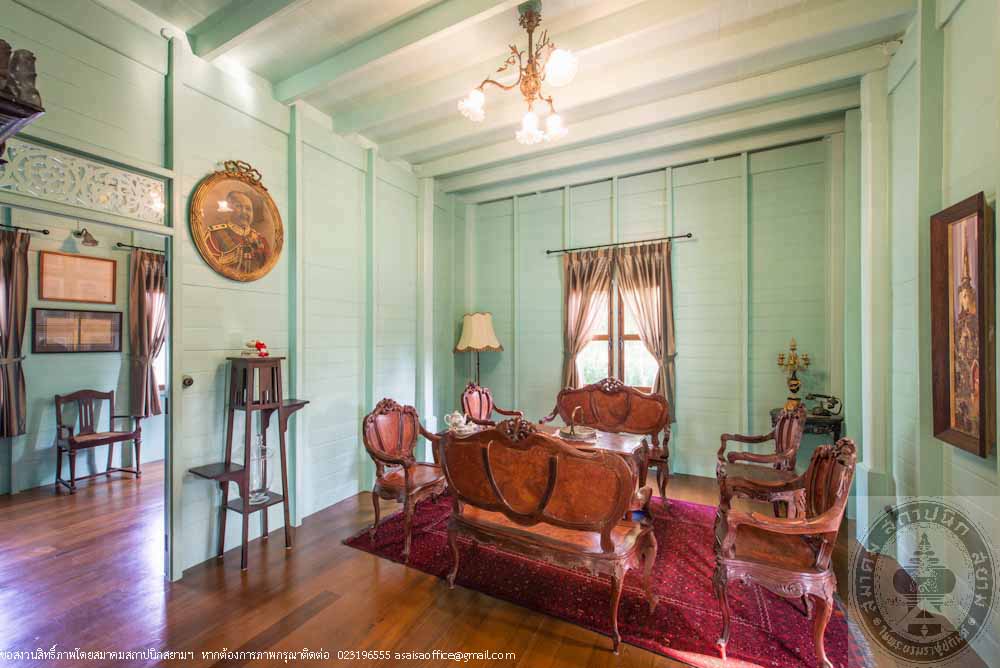
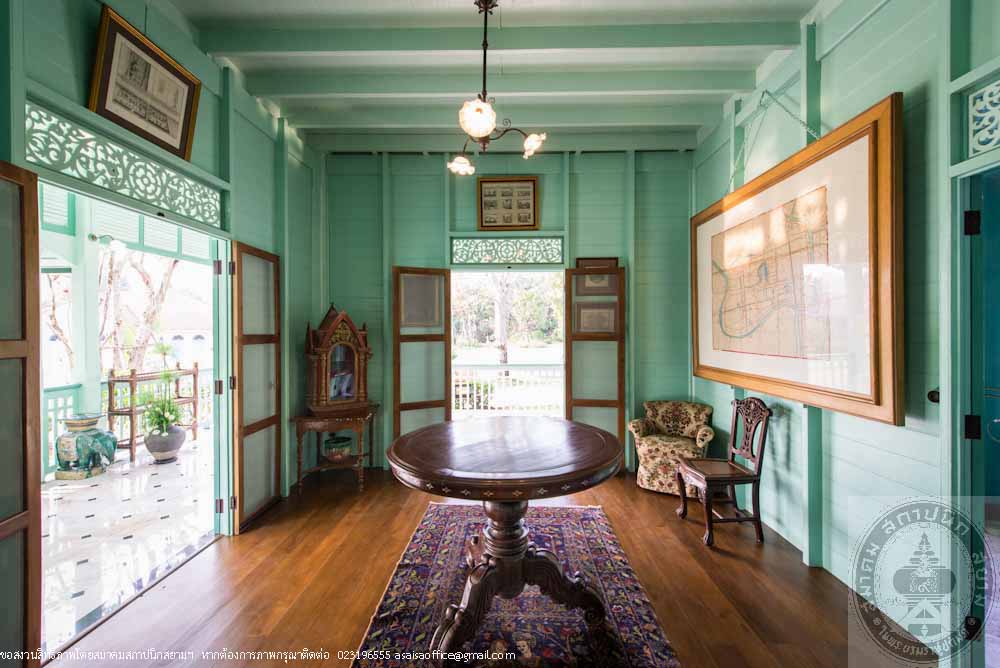
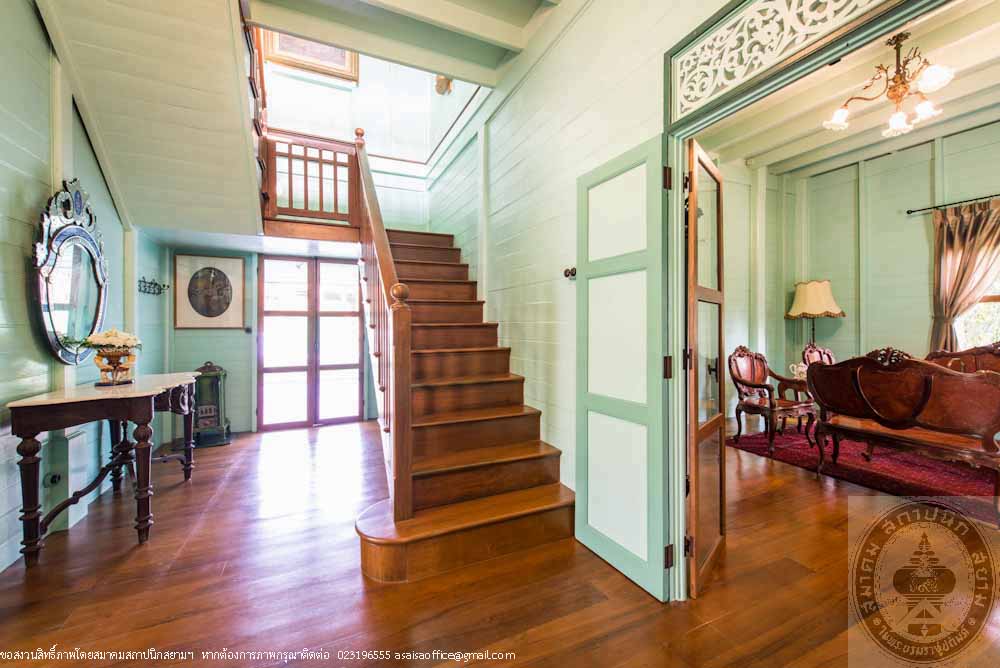


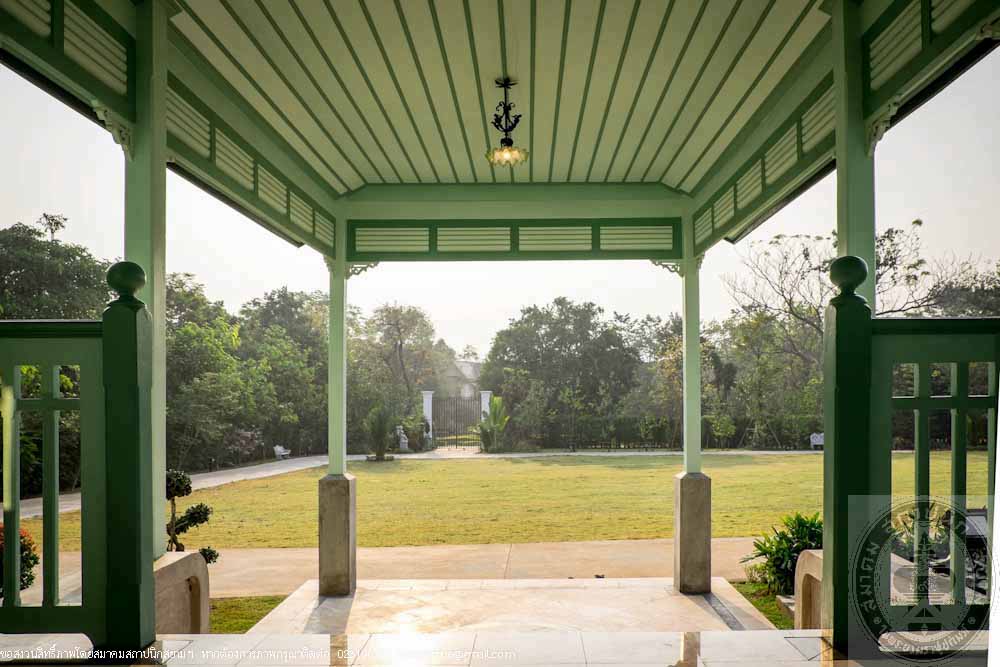
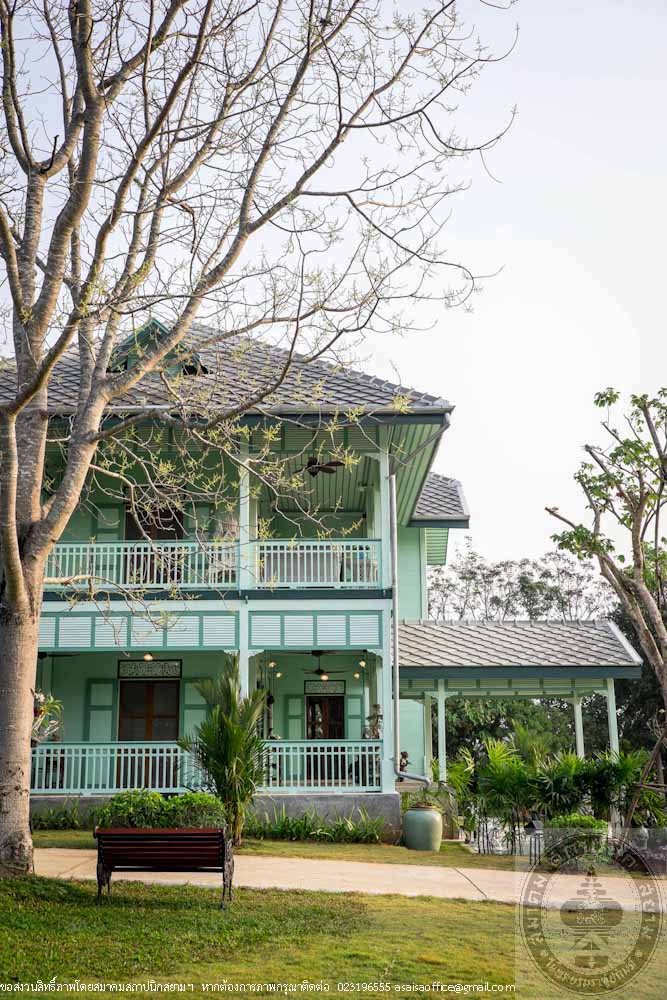
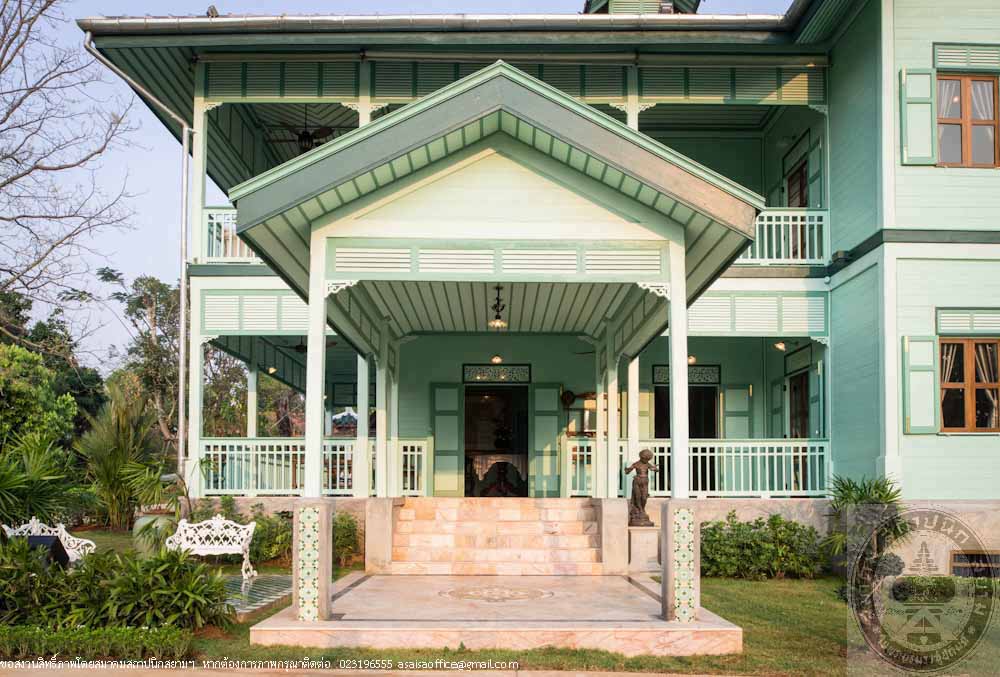
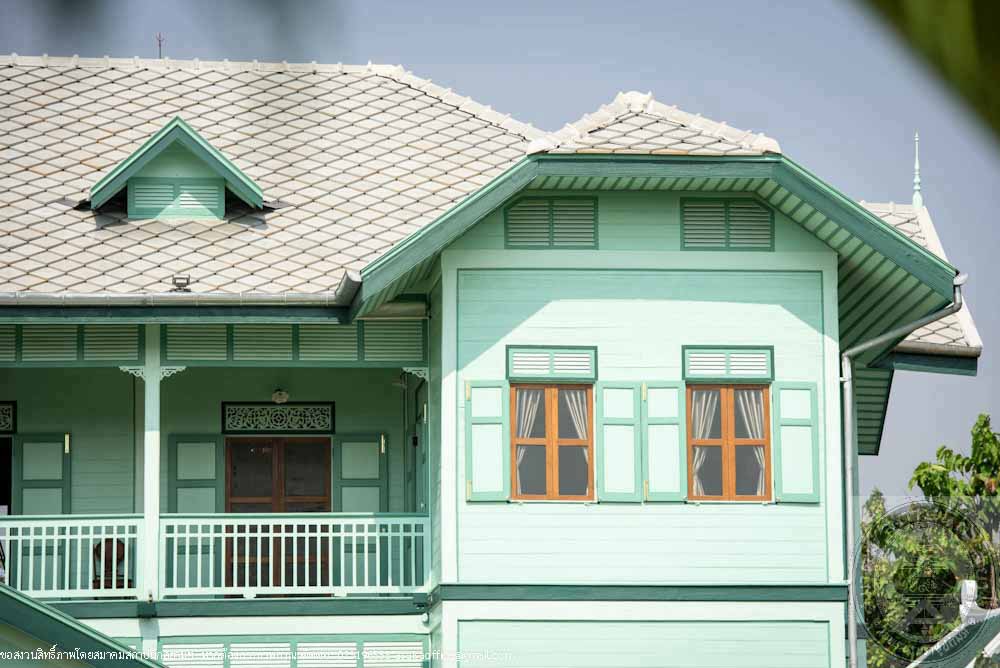

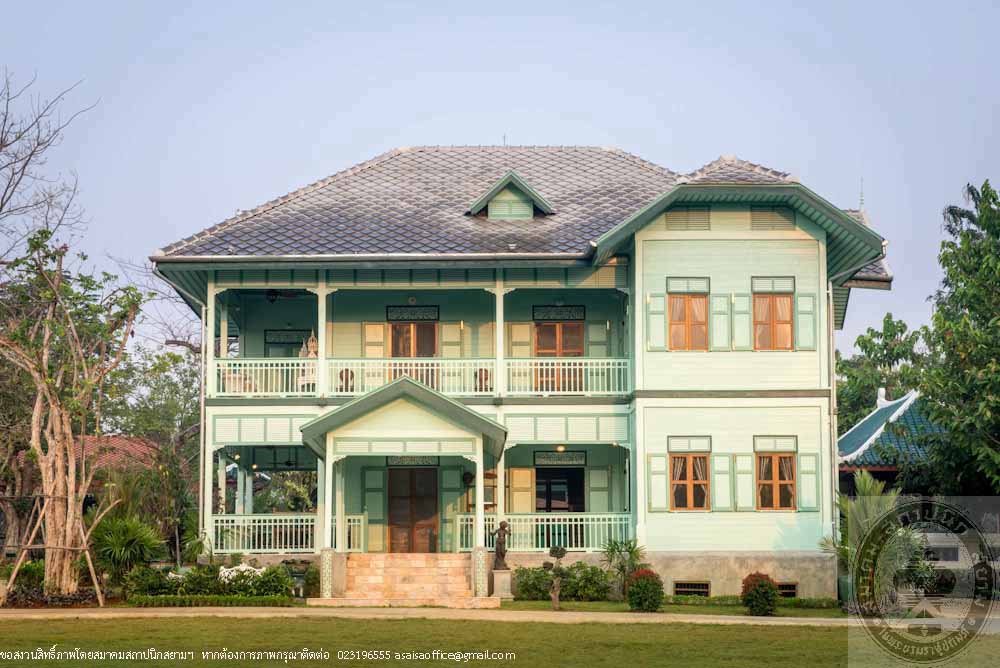

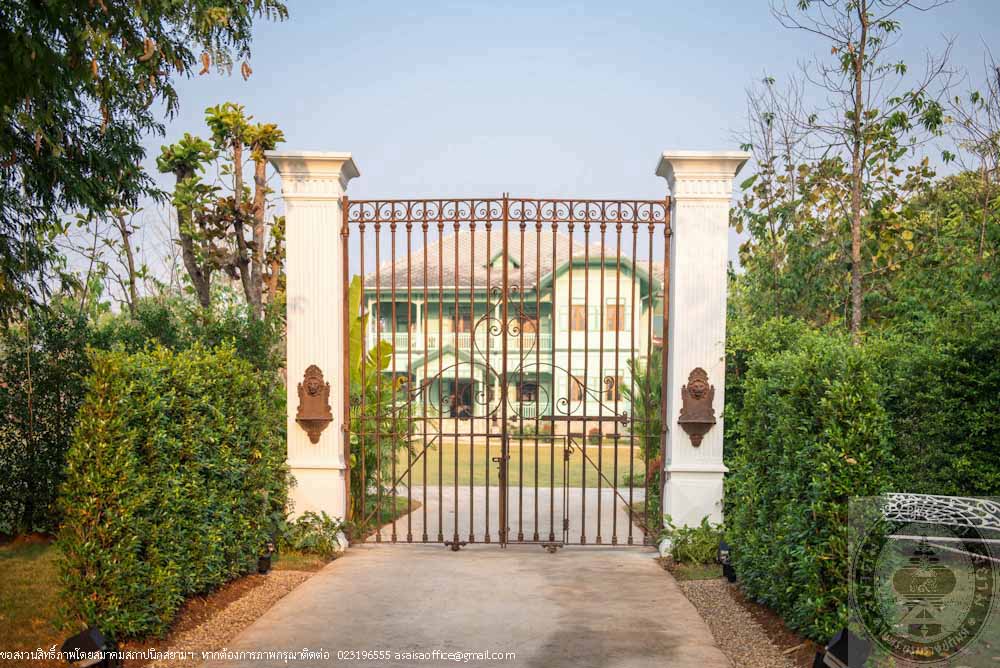
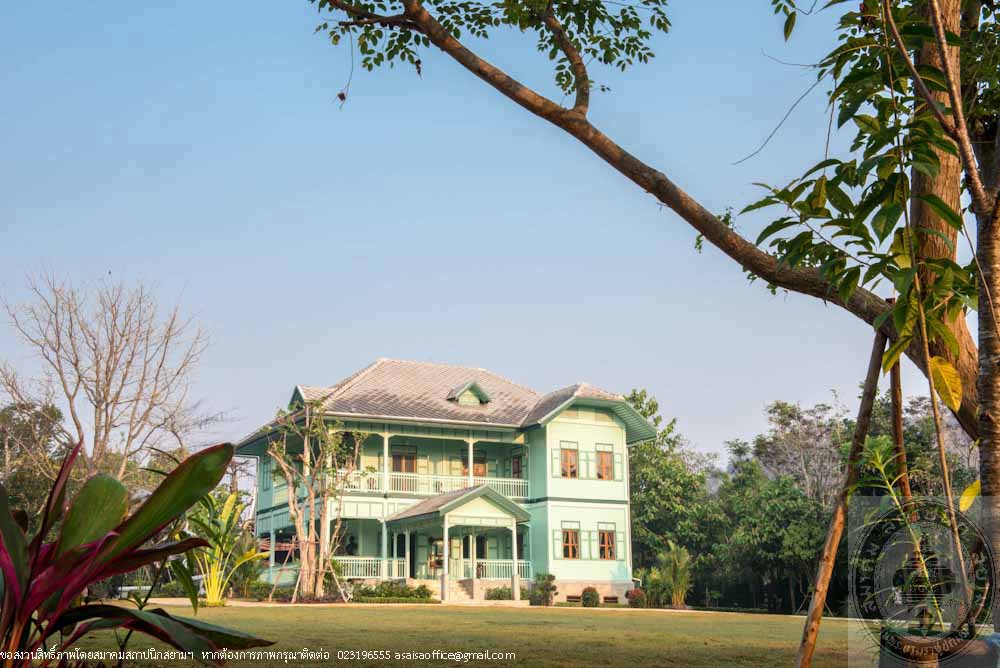
เรือนนางเผอะ (เรือนโคราช)
อ่านเพิ่มเติม
เรือนนางเผอะ (เรือนโคราช)
- ที่ตั้ง จิม ทอมป์สัน ฟาร์ม ตำบลตะขบ อำเภอปักธงชัย จังหวัดนครราชสีมา
- สถาปนิก/ผู้ออกแบบ สถาปนิกผู้บูรณะ: บริษัท สถาปนิกพอดี จำกัด โดยนายพหลไชย เปรมใจ
- ผู้ครอบครอง บริษัท อุตสาหกรรมไหมไทย จำกัด
- ปีที่สร้าง สมัยรัชกาลที่ 4
ประวัติ
เรือนนางเผอะเดิมตั้งอยู่ที่ตำบลพลกรัง อำเภอเมือง จังหวัดนครราชสีมา นับเป็นเรือนครูสำหรับการเรียนรู้เรื่องเรือนโคราชมาเป็นเวลานาน เพราะเป็นเรือนโคราชที่สมบูรณ์และคงสภาพเดิมได้มากที่สุดหลังหนึ่งในจำนวนไม่กี่หลังที่เหลืออยู่ ซึ่งถ้าย้อนกลับไปสมัยรัชการที่ 4 เรือนหลังนี้ถูกสร้างและใช้เป็นที่พักอาศัยของครอบครัวนายสร้อยและนางแหร่ม ทรัพย์สูงเนิน และอยู่กันต่อมาจนยกให้ลูกสาวคนสุดท้องคือนางเผอะ เพ็งพลกรัง ซึ่งแต่งงานกับนายฉ่ำ เพ็งพลกรัง ซึ่งได้ขยายเรือนออกมาด้านข้างเพิ่มเติมจากของเดิม ก่อนจะมาอยู่ในความดูแลของนางอัมพร ยศตรา ลูกสาวของนางเผอะ และในพุทธศักราช 2551 ได้ถูกย้ายมาไว้ที่จิม ทอมป์สัน ฟาร์ม ตำบลตะขบ อำเภอเมือง จังหวัดนครราชสีมา ภายใต้การครอบครองของ บริษัทอุตสาหกรรมไหมไทย จำกัด ซึ่งสร้างขึ้นเพื่อเป็นสถานที่รวบรวมงานสถาปัตยกรรม ศิลปะ วัฒนธรรมและประเพณีของภาคอีสาน ให้คนรุ่นหลังได้เรียนรู้มรดกอันทรงคุณค่าที่สืบทอดกันมาจากบรรพบุรุษของชาวอีสาน
เรือนโคราชไม่ใช่เรือนไทยภาคกลางและไม่ใช่เฮือนอีสาน แต่ได้รับอิทธิพลมาจากทั้งสองภาคจนเกิดเป็นเอกลักษณ์เฉพาะของเรือนโคราช ซึ่งความโดดเด่นทั้งหมดนี้พบได้ที่ “เรือนนางเผอะ” เนื่องจากตัวเรือนมีการสร้างในสองช่วงเวลาที่แตกต่างกัน โดยช่วงแรกสร้างในส่วนเรือนนอนและเกยที่ได้รับอิทธิพลมาจากเรือนไทยภาคกลางอย่างเห็นได้ชัด กล่าวคือเป็นบ้านไม้ชั้นเดียวยกใต้ถุนสูง หลังคามีองศาที่ชันรูปร่างคล้ายจอมแห มีระบบการก่อสร้างเป็นระบบสำเร็จรูป สามารถถอดประกอบได้ทุกชิ้น เสาเรือนเป็นเสากลมยอดเสามีหัวเทียน ฝาบ้านคล้ายฝาปะกนแต่เป็นเพียงลวดลายมิใช่เกิดจากการเข้าไม้ มีการลดระดับของแต่ละส่วนมากกว่า 40 เซนติเมตร จนเกิดช่องว่างที่เรียกว่าช่องแมวลอด ประตูหน้าต่างยึดด้วยสลักเดือยโดยเปิดเข้าภายในห้อง การปลูกเรือนจะวางสันของหลังคาตามร่องตะวัน (หันหน้าจั่วไปทางทิศตะวันออกและตะวันตก) และในช่วงที่ 2 ที่มีการต่อเติมเรือนโข่งต่อออกมาจากเกยของเรือนนอนจะได้รับอิทธิพลมาจากเฮือนอีสาน ที่มีการปรับลดองศาของหลังคาลงมาเหลืออยู่ที่ 40 องศา ฝาตีแนวนอนแต่ยังคงเป็นระบบถอดประกอบได้เหมือนเดิม การต่อเติมส่วนนี้เป็นการต่อเติม เพื่อใช้เป็นพื้นที่เอนกประสงค์ มิใช่เป็นการต่อเติมเพื่อเป็นที่อยู่อาศัยของอีกหนึ่งครอบครัว เพราะว่าภาคอีสานจะยกบ้านหลังใหม่สำหรับแยกครอบครัว และจะไม่ใช้ชานบ้านในการเชื่อมกันแต่จะเชื่อมต่อกันโดยใช้เดิ่น (ลานบ้าน)เดินทะลุหากัน
การวางแผนปรับปรุง บูรณะและอนุรักษ์สำหรับเรือนนางเผอะ เริ่มดำเนินการก่อนที่จะมีการย้ายมาตั้งไว้ที่ จิม ทอมป์สัน ฟาร์ม ด้วยการเก็บสำรวจข้อมูลเกี่ยวกับประวัติความเป็นมา ขนาดขององค์ประกอบต่างๆ และรายละเอียดที่เกี่ยวข้องทั้งหมด ก่อนจะเข้าสู่ขั้นตอนของการรื้อ โดยในการรื้อจะทำสัญลักษณ์ไว้ทุกชิ้นส่วนเพื่อสามารถนำกลับมาประกอบใหม่ตามตำแหน่งเดิมทั้งหมดได้ ส่วนที่ชำรุดและขาดหายจะทำขึ้นใหม่และเติมให้ครบทุกส่วน สำหรับการยกเรือนใหม่นั้นได้เพิ่มฐานรากที่เป็นคอนกรีตเสริมเหล็กสำหรับรับเสาทุกต้นเพื่อยืดอายุของตัวเรือนให้อยู่ได้นานที่สุด มีการปรับเปลี่ยนวัสดุมุงหลังคาจากสังกะสีเป็นแป้นไม้ที่มีสีใกล้เคียงกับสีของตัวเรือน และไม้ส่วนต่างๆ ของเรือนจะถูกทำความสะอาดและทาน้ำยารักษาเนื้อไม้เท่านั้นเพื่อให้เห็นผิวและสี ของไม้ที่อยู่ตามสภาพเดิมให้มากที่สุด หลังจากเรือนนางเผอะได้ประกอบแล้วเสร็จบนที่ตั้งใหม่ก็ยังคงทำหน้าที่เป็นเรือนครูสำหรับเรือนโคราชต่อไป โดยมีผู้สนใจแวะเวียนมาเยี่ยมชมอย่างต่อเนื่อง
Ruan Nang Peu (Ruan Korat)
- Location: Jim Thompson Farm, Takob Sub-District, Pak Thong Chai District, Nakhon Ratchasima
- Architect/Designer: Restoration architect: PO-D Architect Company by Mr. Paholchai Premchai
- Owner: The Thai Silk Company Limited
- Year Built: The reign of King Rama IV
History
Ruan Nang Peu, formerly located at Ponkrang Sub-district, Muang Nakhon Ratchasima, has been recognized as the master of Korat style houses for a long period of time as it was the most complete and remain in its original shape than the others. The house, built during the reign of King Rama IV, as a primary home of Soi and Ram Sapsoongnern. Their family had been living there until the house was finally passed on to Nang Peu Pengponkrang, the youngest daughter. Nang Peu married Nai Cham Pengponkrang who expanded the house by building an addition on the side. The house later became under the care of Nang Ampon Yodtra, Nang Peu’s daughter. In 2008, the house was relocated to Jim Thomson Farm in Takob Sub-district, Muang Nakhon Ratchasima under the possession of The Thai Silk Company. The farm was established to house collections of northeastern architectures, arts, cultures and traditions in order for the future generations to learn about the valuable heritage of their ancestors.
Korat style house is neither of central Thai nor Isan architecture, but was a blend of both regions that give it its unique features, all of which can be found in “Nang Peu House.” The house was built in two different periods. The first part built was the sleeping quarter and the mounting platform which was obviously influenced by the Central Thai architecture for it is a one storey house raised on stilts with steep roofs at an angle that resembles the pyramidal roof. The house is modular built and can be disassembled for rebuilt. The pillars are of round shape with tenon joints on the top. The wood-like wall panels are created with patterns. The level of one quarter is built at more than 40 centimeter lower than another. The gap between each level is left open called “the cat’s gate.” Doors and windows are attached to the frame with dowels, and swing into the room. To build a house, the roof ridge is usually positioned to parallel the sun light. (Gables facing east and west) The second period was when another quarter was added to the mounting platform of the sleeping quarter and was influenced by the Isan style architecture whereas the roof pitch was adjusted to 40 degree angle. The wall panels are still of wood planks installed horizontally and are being completely modular. This new space was built to add a multipurpose area to the house, not for another family to live. In the northeast, the new family will be given a new home within the same compound and houses will never be adjoined with a terrace. Instead, they will be sharing a courtyard where people walk through from one house to another.
